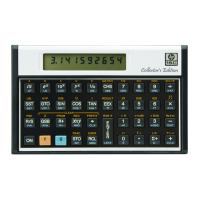168 Section 12: Calculating with Matrices
Writing down the elements of C,
C =
1.000 −2.8500×10
−10
−4.0000×10
−11
1.0000
1.0000×10
−11
3.8000×10
−10
1.0000×10
−11
−1.0500×10
−10
= (ZZ
−1
)
P
,
where the upper half of matrix C is the real part of ZZ
−1
and the lower half
is the imaginary part. Therefore, by inspection of matrix C,
ZZ
−1
=
1.000
−2.8500×10
−10
−4.0000×10
−11
1.0000
i
1.0000×10
−11
3.8000×10
−10
1.0000×10
−11
−1.0500×10
−10
As expected,
ZZ
−1
≈
1 0
0 1
i
0 0
0 0
.
Solving the Complex Equation AX = B
You can solve the complex matrix equation AX = B by finding X = A
−1
B. Do
this by calculating X
P
= (Ã)
−1
B
P
.
To solve the equation AX = B, where A, X, and B are complex matrices:
1. Store the elements of A and B in memory, in the form either of Z
P
or
of Z
C
.
2. Recall the descriptor of the matrix representing B into the display.
3. If the elements of B were entered in the form B
C
, press ´ p to
transform B
C
into B
P
.
4. Recall the descriptor of the matrix representing A into the display.
5. If the elements of A were entered in the form of A
C
, press ´ p
to transform A
C
into A
P
.

